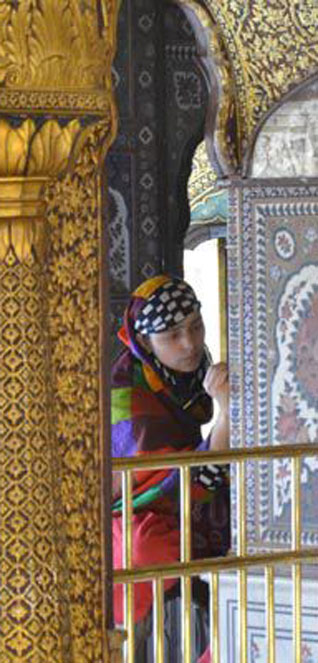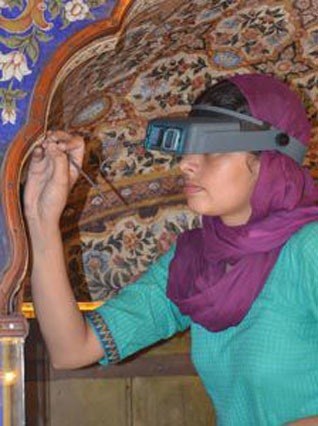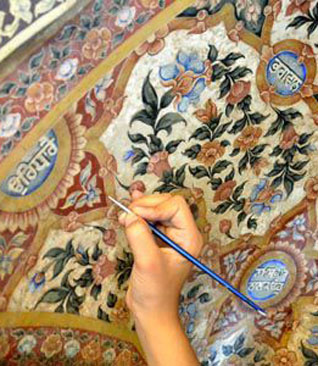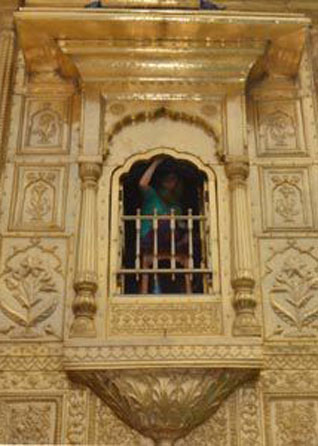Art
The Conservators:
The Ageing Art of The Darbar Sahib
USMEET KAUR
Universal spirituality, timeless art and irrepressible young artists are in perfect harmony for restoration work at The Golden Temple -- The Darbar Sahib of Amritsar.
These artists are breathing new life into many art forms that find a place at this holiest of holies.
Since the Harmandar is known as The Golden temple, the first and most aspect of the complex is its gold-embossed work, found on all domes, the inner walls of Harmandar Sahib, and the door panels. Special designs have been given to copper sheets that are further covered by gold leaves.
The other type is inlay work -- beautiful designs depicting birds, animals, flowers engraved in marble, coloured and studded with colorful, semi-precious stones.
The art is part of a centuries-old tradition.
The architectural prototype of The Golden Temple came into being as an idea combining a dharamsala and sarovar envisaged by the Fifth Master, Guru Arjan.
Instead of building the gurdwara on a high plinth, he had it built in a depression so that the worshipper had to go down in humility to pray at the Lord’s House.
The 16th-century building was later repaired and enhanced by Maharaja Ranjit Singh in 1802, an act commemorated by an inscription over the entrance to the central shrine. It was he who donated Rs 500,000 for sheets of gilded copper on the roof.
With time, the community added to the fund.
For the latest work, it was in December 2013 that the Shiromani Gurdwara Parbandhak Committee (SGPC) hired a firm that tasked Chandigarh-based conservator Namita Jaspal, director and chief conservator at Heritage Preservation Atelier Private Limited, and her team with the project.
Narrating the process, she said, “We have actually worked on the uppermost layer of the paintings -- work done in 1960 by Atma Singh. First, some pre-consolidation work was carried out, and then came the cleansing process, which was done by dry and wet methods that were very mild and safe for the paintings.”
She also shared her assessment of damage and the team’s approach.
“Conservation work for wall paintings and murals was started in December by my team members, who are from Leh, Delhi, Haryana, Assam, Chandigarh, Pune and Punjab. Initially, they worked on three broad categories of damage -- first, the paintings that are hidden under stubborn layers of dark grime; then those that are varnished and hence yellowed; and also on paintings that are covered by glass.”
About the consolidation process, she explained, “It’s done to fix loose layers of paintings. Material used for consolidation is compatible with the original material used, and this is also reversible. That means it can be taken out wherever required in future without damaging the original paintings.”
All the processes and materials are in accordance with the international code of ethics of conservation, according to Namita.
TEAM WORK
Talking about the team, Namita asserted, “First, we need to understand that restoration and conservation work is not only artwork but a blend of science and art. My team includes expert conservators as well as artists. And the most important thing is that they haven’t overlapped the original work. Rather, besides preserving the art, even the gaps are being in-painted while restoring the beauty.”
Currently the in-painting process is being carried by a young team of students and lecturers, majority of them from Punjab.
“We are purposely training young artists from Punjab so that in the next 5-10 years, if the restoration of art is needed again, these youngsters are readily available,” Namita said.
Among the artists is Manveer Singh, 27, a lecturer in fine arts from Ludhiana, who explained the routine: “Earlier, we used to work from 10 am to 5 pm, but, because of the extreme heat and light, we now work 7.30 am to 2.30 pm.”
“Our main work is to retouch the art in a way that the old form remains intact. The biggest challenge is matching the color,” he said, adding, “See, basically these walls already carry art; they are not like a white canvas on which we can use free brushstrokes. The other challenge is creating a natural earthen colour to look like the 200-year-old colour.”
‘A BLESSING’
Supreet Kaur, a 23-year-old fine arts student from Amritsar, says: “It is my first job and I couldn’t have asked for more. I feel I am blessed I was chosen for this work. Actually, even if I wasn’t paid for it, I would have opted for it. Anyway, we are being paid well for the hard detailing we do all day.”
Manjot Kaur and Mandeep Kaur added, “Working in the arches definitely gives us shoulder pain, cervical problems, as we have to keep our necks at a 90-degree upwards.
“Miniature work also affects our eyesight, but we don’t care about that as this is the biggest project we have. Plus, listening to soulful gurbani the whole day and working here is a delight!”
About the response from visitors, they are thrilled.
“People come and give us blessings. They are proud to see that our team is mostly comprised of girls. Now that only around two months’ work is left, everyone’s looking forward to seeing the final product of our team’s hard work.”
THE DETAILS
The Idea: Restoration of artwork at The Golden Temple was necessitated as visitors started pointing out flaking. Before 2013, too, it was done, but random painters or artists were called for it. Even some Rajasthani artists were invited but they tried to make new paintings and were stopped. Finally, the SGPC planned to rope in professionals to basically work on the uppermost layer that was restored in 1960.
The People: When tender was floated, a Gurgaon-based company, Drona, won it and outsourced the work to Namita Jaspal and her firm. Namita has experience of such work since 1995. They started with a team of seven: six conservators and an archaeologist. Now, in-painting process is going on which includes a team of four conservators and six artists.
The Tools: About the paints and brushes used, Namita says: “We have used very fine brushes, and paints have been made by us by mixing mineral or earth pigments. Material used for consolidation is compatible with original material used; this is also reversible, so that it can be taken out wherever required in future without damaging the original paintings.”
The Target: “When we started, we knew how to stop the damage. Under ethics of conservation, within six months we have been able to do that.“ Talking about areas of focus, she listed the first floor specifically, “as it is all painted and was going through different types of damage”.
The two main problems observed were: in the glass-covered areas, the paint was coming off and flaking was seen since dust was trapped inside the glass; in the varnished areas, brown patches had developed and cracks were spotted.
[Courtesy: Hindustan Times. Edited for sikhchic.com]
July 14, 2014
Conversation about this article
1: Morressy (Toronto, Ontario, Canada), July 14, 2014, 10:28 AM.
"These artists are breathing new life into many art forms that find a place at this holiest of holies." Don't know if i'm a fan of this re-painting; the relative inexperience of these youngsters is a cause for concern. I'm all for stopping the further deterioration and preservation aspect but taking it upon themselves to touch-up and re-paint is troubling.
2: T. Sher Singh (Mount Forest, Ontario, Canada), July 14, 2014, 10:46 AM.
I share the concern. Surely, the experts who tackled, for example, the recent restoration of the Sistine Chapel could have been consulted. The SGPC does not lack funds. Sadly, it also does not lack both ignorant, negligent and corrupt officials who, I fear, would have found it more monetarily expedient -- possibly for personal gain -- to hire a local company, which in turn has hired inexperienced and cheap labour. Training the new generation is a great idea but I'd rather they were trained by the world's top experts than by desis with limited or no experience in this sort of restoration work. Sorry, but I've no difficulty in saying that I don't believe that the expertise needed in this important but delicate operation is to be found in India.
3: Baljit Singh Pelia (Los Angeles, California, USA), July 14, 2014, 1:45 PM.
Anything the SGPC does is suspect to me. Over the years they have awarded lavish contracts to their cronies for kickbacks in the name of kar sewa to marbelize many of the historical gurdwaras, which in the process lost their historical character when the 'old' was either marbled over or simply destroyed. Hundreds of gurdwaras across the border lie crumbling and in a shocking state of disrepair, to eventually disappear, taking with them the associated heritage and istory. This contract without due process and involvement of artists and experts in the field of restoration is very serious. The preservation of this work must have been assigned to the experienced rather than giving it to students trying to gain experience or for training. There are many places around the parkarma where they could have been given opportunities to develop their skills while improving the aesthetics.
4: K P Singh (Indianapolis, Indiana, USA), July 15, 2014, 8:54 AM.
We have lost many irreplaceable art treasures due to neglect or thoughtless design, to wars and wanton neglect. Whereas doing nothing to save, preserve, and restore is a terrible and unpardonable option. Today we do have access to the experts and technology that can preserve our treasured heritage far into the future for generations of humanity to marvel at and get a glimpse of the arts, spirit, and creativity that adorn the holiest shrines and the heart and soul of the Sikh faith and Sikh people. This blessing to preserve and restore and to thoughtfully recreate the true magnificence and beauty of art treasures is a task that should be led by the best experts from around the world. High-minded criticism alone is not the answer, but impressing upon those responsible to undertake and assign such sacred responsibilities that they view and understand the true significance of our relics and surviving elements, a timeless window to the journey of the faith, is a task that deserve the highest wisdom and search for the best talents. The awakening to preserve is a welcome sign, but to place this work in the hands of young students without the best advice available may be shortsighted and a major mistake in itself. I for one would not doubt the dedication and great devotion of the team of young artists working on this monumentally-significant seva, but we must feel reassured that they have the benefit of the best experience and respected masters in the field. India has been a land of incredible creativity from times immemorial and all experts are not in the West. Urgency is good in such matters, but we must do it right. The world debated for years about the restoration of Michelangelo's Sistine Chapel; the Last Supper in Milan; or the paintings in the Ajanta Caves, before using the first brush; or offering a verdict about the authenticity of the believed Shroud of Christ at Turin with a single fiber. Our focus and attention must be to safeguard every sacred relic of our Gurus, the surviving sacred Hukamnamas, the artworks that adorn our historic gurdwaras, the architectural treasures in disrepair, and the sacred legacy of one of the major religions of the world. These do not belong to the Sikhs alone, they are a part of the entrusted collective sacred heritage of all mankind. To recognize that, we would need a new mindset and a prayer.






